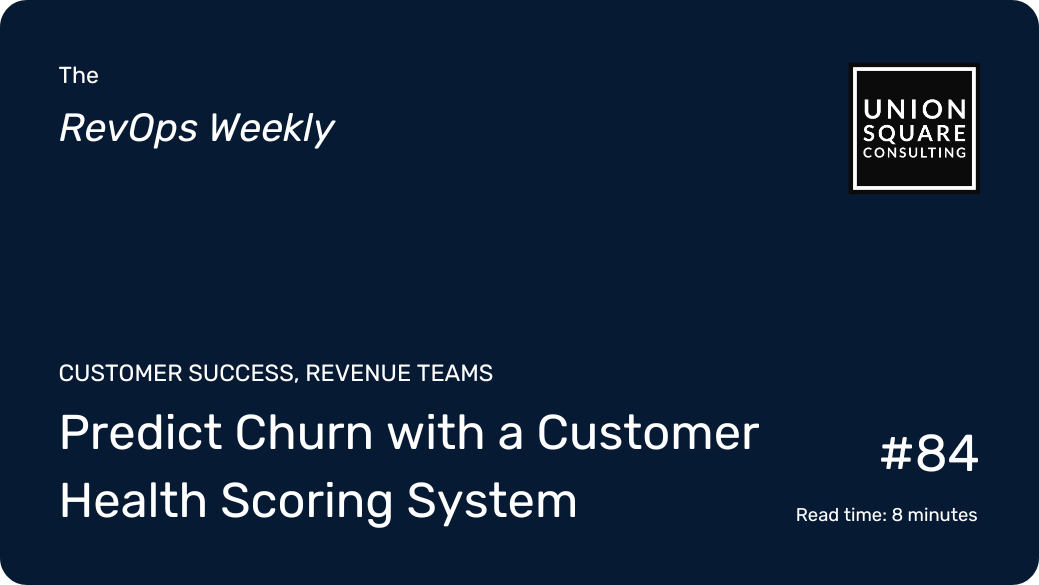
Predict Churn with a Customer Health Scoring System
Read time: 8 minutesDownload the PDF Version: Click Here
If you lead revenue at a high-growth B2B SaaS company, you know this pain all too well:
Your company is generating millions—maybe even billions—in ARR. Growth targets keep getting higher. But customer churn is bleeding revenue faster than you can replace it.
At board meetings, you’re answering hard questions:
- Why are top accounts churning?
- Why is NRR stagnating—or worse, declining?
- Why didn’t we see these churn risks sooner?
You have data—tons of it—but it’s scattered across multiple systems: product analytics, customer success platforms, CRM, support tickets. Customer health scores exist, but they’re either too simple (like a red-yellow-green system) or too noisy to trust. Meanwhile, your CSMs are making subjective calls about account health, and your finance team is struggling to forecast churn accurately.
The result? No one truly knows where the risk is coming from until it’s too late.
This isn’t just a Customer Success problem—it’s a revenue problem. That’s why we analyze NRR and Expansion as key GTM motions in our GTM Efficiency Pyramid Framework. In today’s market, efficient growth is king, and preventing churn is just as critical as winning new deals.
Yet, many B2B SaaS companies fail at building a Customer Health Scoring (CHS) system that actually predicts churn before it happens—because they’re tracking the wrong signals, weighting metrics incorrectly, or failing to act on insights at scale.
In this newsletter, we’ll show you how to fix that.
We’ll break down:
- The right metrics to track—not just usage data, but financial, sentiment, and engagement signals that drive retention.
- How to weight and combine these metrics to get an accurate, actionable health score.
- How to leverage AI and predictive analytics to stop relying on gut instinct and start identifying risk early.
- How to actually operationalize your CHS—so it drives proactive expansion and retention, not just another dashboard.
By the end, you’ll have a clear, structured approach to building a Customer Health Scoring system that doesn’t just track churn—it prevents it.
Let’s dive in.
1. Start with the Outcome
Before you define metrics, assign weights, or write formulas, you need to get clear on what churn actually looks like—in your business, with your customers, in your product.
Because a health score built on the wrong assumptions won’t just fail to predict churn—it’ll actively hide it.
The most accurate CHS systems don’t start with a list of “best practices” or copy-pasted templates. They start by reverse-engineering outcomes.
Pull a list of all the customers who have churned in the last 6–12 months. Then pull the ones who renewed and expanded in that same window. Now look back 90, 180, even 270 days.
- What behaviors did retained or expanding customers show that others didn’t?
- What signals did churned customers show before they left?
- What data did you already have—but didn’t act on?
A signal that indicates risk for one product might mean nothing for another. That’s why usage metrics like “logins” or “feature adoption” can be so misleading. A team might log in every day and still be at high risk—because they’re not using the product in the way that matters most.
2. Identify the Right Metrics (Beyond Just Product Usage)
Most CHS systems fail because they over-index on product usage. While usage matters, it’s only one piece of the puzzle. Customers don’t churn just because they log in less frequently—they churn because of a mix of financial health, engagement trends, and overall account experience.
A predictive CHS should include a combination of four key metric categories:
1. Product & Usage Metrics
- Feature adoption – Are customers using the right features for their use case?
- Breadth of usage – Are multiple users engaged, or is it just one champion?
- Depth of usage – How frequently are they using the product?
2. Engagement & Relationship Metrics
- CSM interactions – Are they engaging with their CSM, or going silent?
- Support tickets – Are they submitting more issues than usual, or ghosting support entirely?
- Community participation – Are they active in your user groups, webinars, or forums?
3. Financial & Contract Metrics
- Invoice history – Have they been paying on time, or are there delays?
- Contract structure – Are they on a flexible contract or locked into a multi-year deal?
- Discounts & expansion trends – Are they growing their spend or scaling back?
4. Sentiment & Feedback Metrics
- NPS & CSAT scores – Are they happy, or have scores declined?
- Survey comments & qualitative feedback – What are they actually saying?
- Executive engagement – Is leadership engaged, or has their champion left?
Individually, these metrics don’t tell the full story—but combined, they create a data-backed holistic picture of account health.
3. Standardize and Score Your Metrics
Once you’ve identified the right metrics, the next step is to standardize them onto a common scale. This allows you to blend multiple data types into a single, actionable score.
Here’s an example of how this might look:
This ensures that low engagement in one area doesn’t completely distort the overall score, while still flagging risk patterns early.
4. Assign Weighting Based on Churn Predictiveness
Not all metrics predict churn equally. Some are leading indicators, while others are lagging signals.
For example:
- Low product usage might indicate risk, but it doesn’t necessarily mean churn is imminent.
- A missing executive sponsor or negative NPS score? Huge warning signs.
Your weighting should reflect this:
By assigning strategic weighting, your CHS moves from a generic score to an accurate predictor of churn.
5. Put the Formula Together
Now, let’s put it all together in a formula we can use to calculate our Customer Health Score.
This formula is a simple example than can and should be customized and iterated on for your own situation (and each product). We’re going to multiply our action scores (A#) by their corresponding weights (W), then add them all together:
Using our example figures above, our formula would look like this:
CHS = (8×0.3) + (5×0.25) + (7×0.2) + (6×0.15) + (3×0.10)
CHS = (2.4) + (1.25) + (1.4) + (0.9) + (0.3)
CHS = 6.25
We can interpret the score on a scale like this:
9-10 → Healthy (Low Churn Risk, Expansion Opportunity)
7-8.9 → Stable (Monitor for Risks)
5-6.9 → At-Risk (Requires Proactive Intervention)
<5 → Critical (High Churn Risk, Immediate Attention Needed)
In which case, a score of 6.25 would be at-risk, meaning Customer Success should intervene to prevent churn.
6. Use Predictive Analytics and AI for Early Warnings
Traditional CHS systems rely on static rules. The problem? By the time a customer hits the “at-risk” threshold, it’s often too late.
Instead, leverage AI-driven predictive analytics to:
- Detect micro-patterns in account behavior that lead to churn.
- Identify silent churn risks, like a decline in executive engagement before contract renewal.
- Surface accounts at risk months in advance, allowing for proactive intervention.
Companies like Gainsight, Totango, and Vitally offer AI-powered models that ingest multi-dimensional data and predict risk before it materializes.
7. Operationalize Your CHS for Real Impact
The biggest mistake companies make? Treating CHS as just another dashboard.
To make customer health scores a proactive tool in your revenue strategy, they should be embedded into:
- Customer Success workflows – Automate playbooks for at-risk accounts.
- Revenue forecasting – Connect CHS with renewal forecasting models.
- Account expansion efforts – Use CHS to identify customers primed for upsell.
- Executive reporting – Give CROs real-time visibility into churn risks.
8. Continuously Iterate and Improve
A CHS isn’t a set-it-and-forget-it system. Over time, refine:
- Metric selection – Are certain signals more predictive than others?
- Weighting adjustments – Should some factors carry more weight?
- Automation rules – Can intervention workflows be further optimized?
A/B testing different CHS configurations will ensure it remains an accurate and actionable tool for revenue teams.
Final Thoughts
Revenue leaders at high-growth SaaS companies can’t afford to react to churn—they need to predict and prevent it.
By implementing a well-structured Customer Health Scoring system, you gain:
- A repeatable, scalable system that drives revenue retention and expansion.
- A data-driven approach to forecasting churn before it happens.
- The ability to prioritize accounts for proactive intervention.
If your current CHS isn’t delivering these outcomes, it’s time to rethink your approach.
Want help building a CHS that actually works? Let’s talk.
When you’re ready, here’s how we can help:
Get a Free 1:1 Revenue Efficiency Workshop
Get one of our Senior Revenue Strategists to yourself for 1 hour and leave with an initial plan to begin optimizing your go-to-market operations.
Hire Us!
Bring us on as your Strategic GTM and RevOps Team, for help with Growth Planning, GTM Process Design, Reporting/Data Insights and Systems Architecture.
Get more tips like these, sent right to your inbox.
Subscribe for fresh, relevant revenue growth tips delivered every week.
